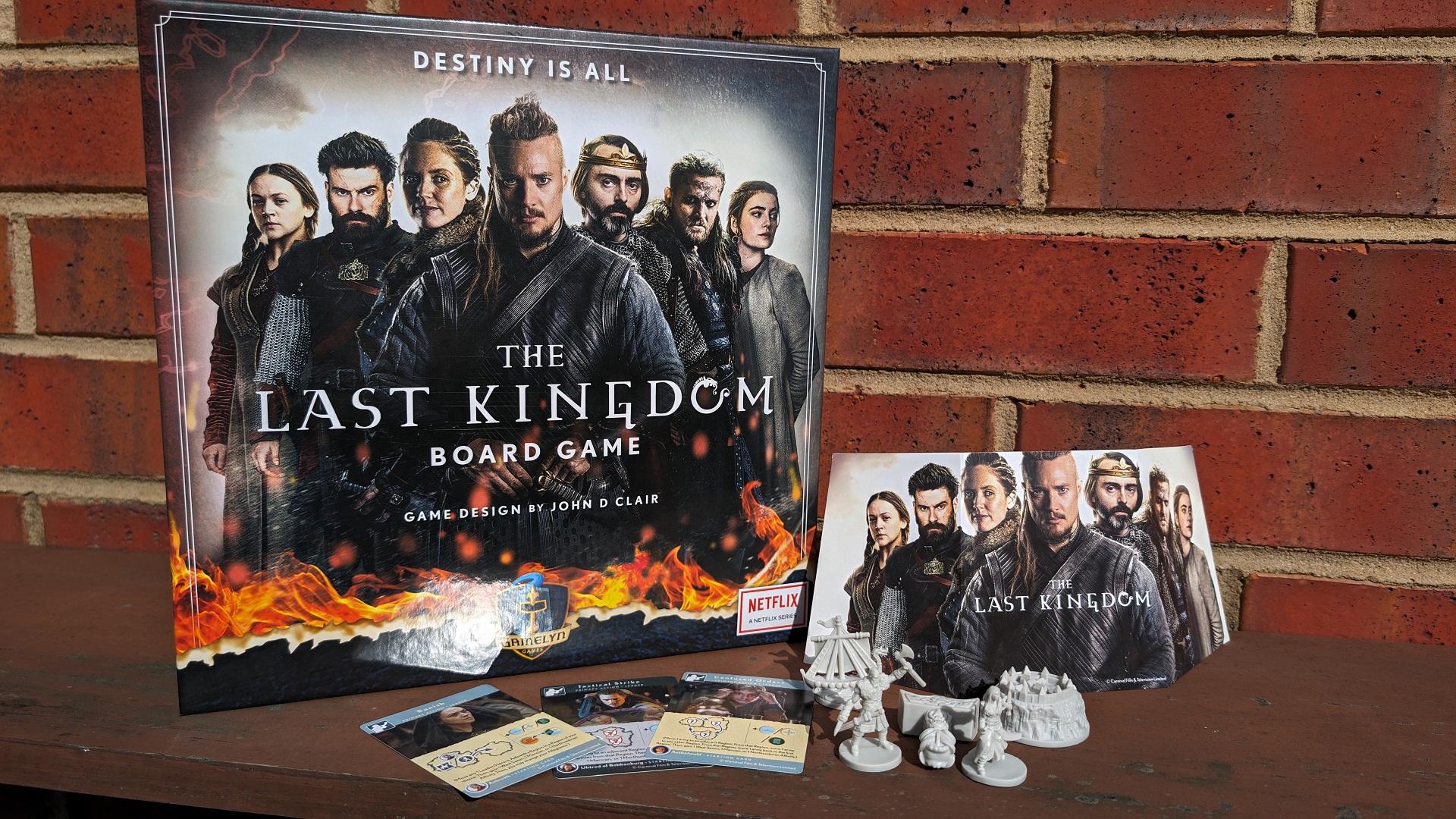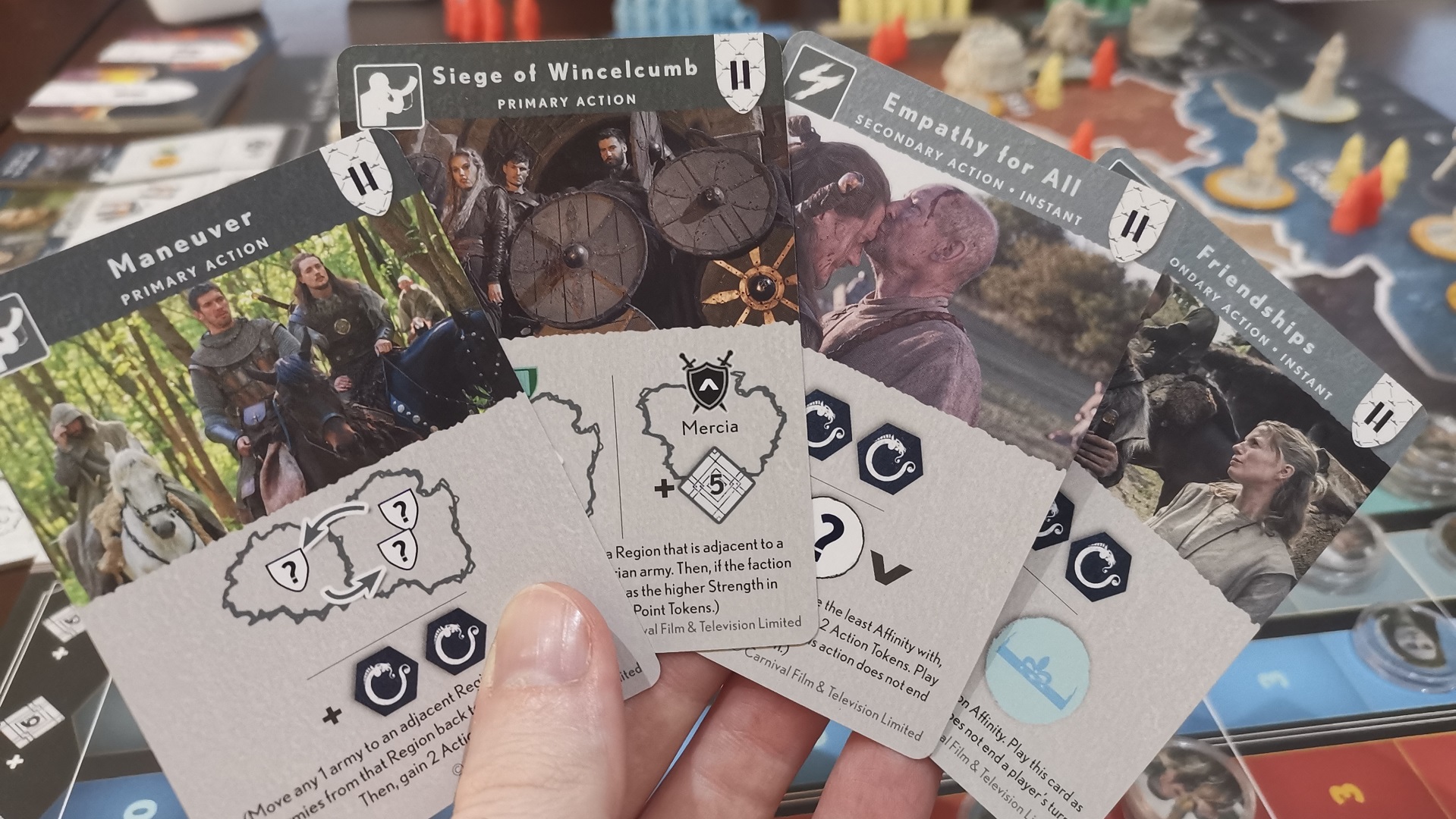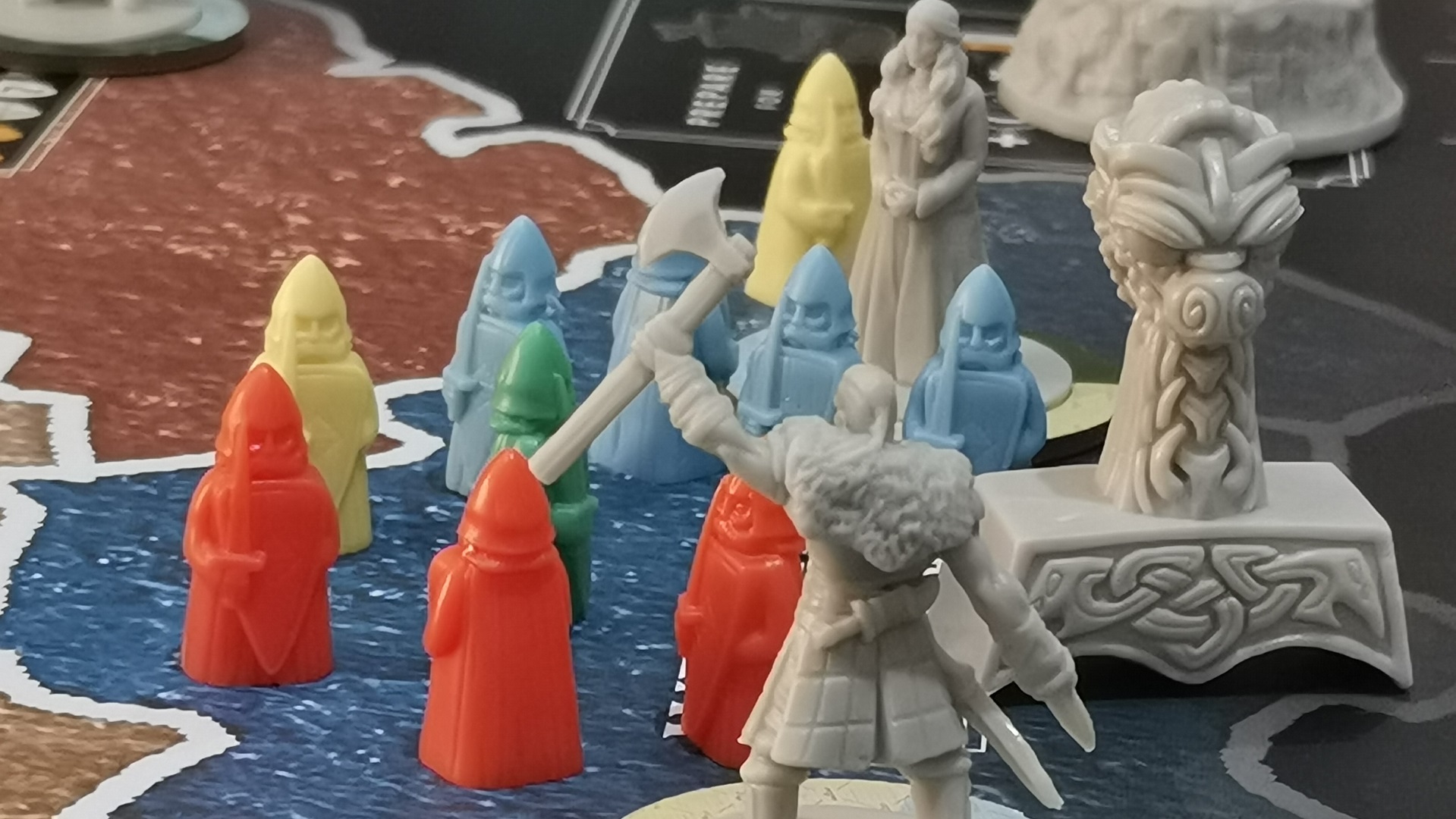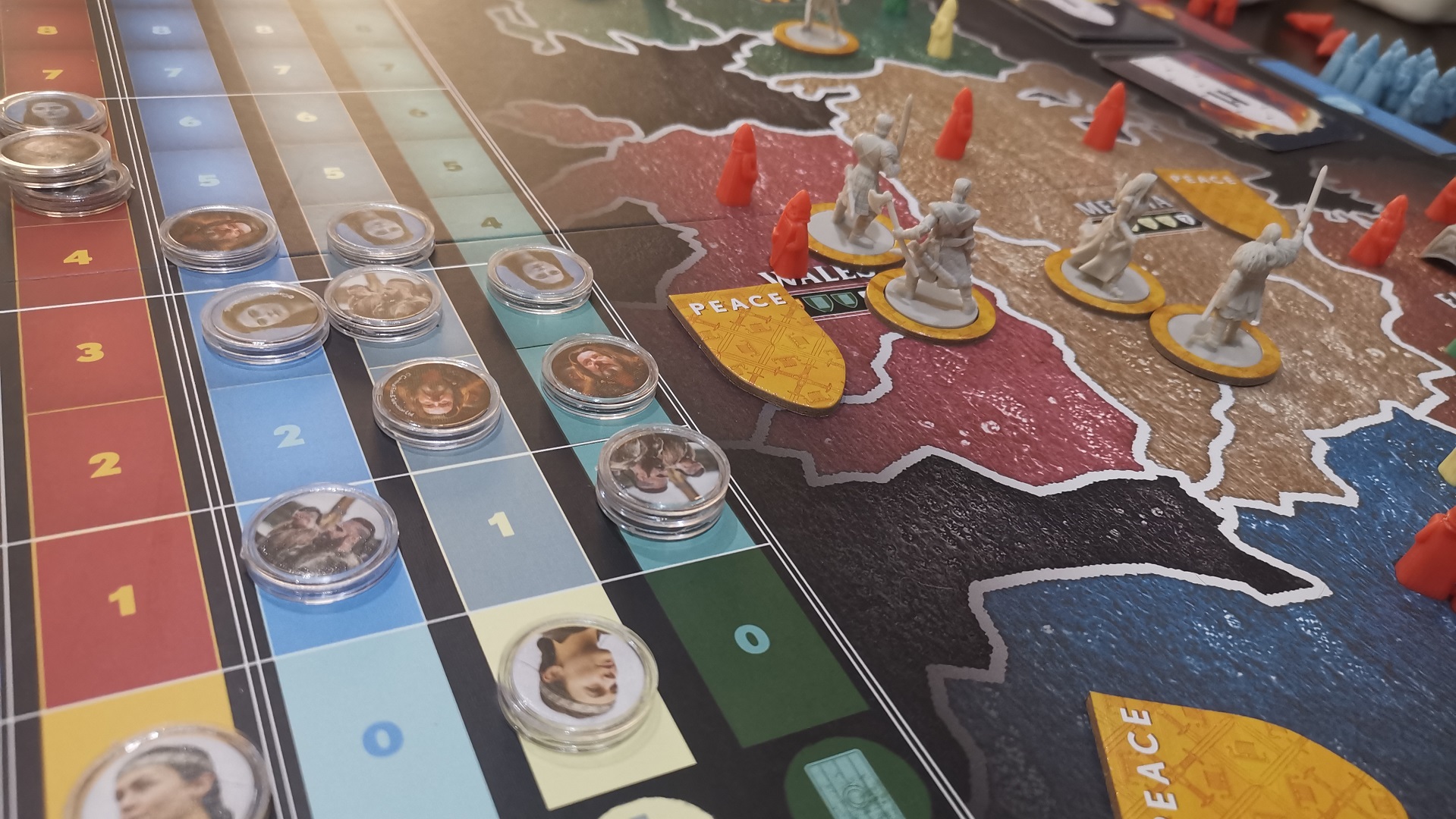The Last Kingdom’s Danes versus the Saxons drama and its tale of warriors and monarch’s flip-flopping allegiances are brought to life with impressive thematic flair in the board game adaptation of the historical Netflix drama. Fans of the series are treated to an ambitious game of settling conflicts across the five regions of Wessex over two rounds, with players switching allegiances between the invading Danish and Saxon factions as they bid to be on the winning side of the five regional battles. Designed by John D Clair, creator of the racing game Cubitos and betting game Ready Steady Bet, The Last Kingdom: The Board Game arrives on the back of a great string of titles from wildly varying genres. By pulling together elements of card drafting, action selection, and a touch of diplomacy, what initially looks like a ‘dudes on a map’ game is a tense, slow burn of ego-draining losses and expensive, gratifying victories.
Seated around the table with a placard to keep your available action tokens and amassed victory points hidden from your fickle allies and opponents, the first step is choosing your unique leader, their pair of powerful action cards, and neat little miniature depicting a popular character from the series. From here, players then proceed to draft a handful of cards from the deck corresponding to the current round. Starting in the deep end with a pick-and-pass of unique and game-changing cards can be an intimidating prospect, but here the cards have an easily understandable description of their function in play. Among these cards are also special hero cards, which allow players to manoeuvre further famous faces onto the map with unique abilities.
Determine your destiny with a card draft
During a newbie’s first game, virtually every card is brimming with situational possibilities that can sway the composition of armies in a region or move the conflict to another region altogether. There is a tremendous satisfaction that comes with playing many of these cards, watching the aghast faces of your group as they realise their expensive and meticulous plans have been majorly waylaid. With every player invested in the outcome of each of the game’s ten conflicts, each card played and action taken at the table is watched with bated breath and eagle eyes. The tension is helped by never knowing how well the competition is faring, with their piles of victory points hidden at all times, the winner having accrued the most once the second round’s five conflicts are resolved.
Unlike popular strategy games such as Risk, players are not in direct control of The Last Kingdom’s armies. Instead, everyone shares in manipulating and repositioning both the Dane and various Saxon armies across the English isle. Because a player isn’t strictly tied to either side, the toothiness of The Last Kingdom comes down to making sure you are allied with the winning side in any given conflict. This can and will mean that some conflicts will see all the players allied to the same cause. In more common scenarios, a player will be skint on the necessary cards or action tokens required to jump the fence, praying that they can instead influence armies into or out of the conflict region and force the outcome in favour of their faction. Once every player ceases playing cards and actions to transform the balance of a region in conflict, varying cashouts of victory points are awarded to players allied before moving on to the next conflict marked on the board. The resulting hilarious diplomatic cowardice plays out smoothly with rich thematic flair, with certain leaders often boosting the effectiveness of factions that they might be considered favourable towards on the show.
The plastic leader and hero minis provide a great visual contrast in the conflicts
Learning the game isn’t overly strenuous, mostly aided by the clear card descriptions and a concise manual filled with examples of play. The actual rules for the game are neatly condensed into 6 pages, with plenty of clear image examples of the game’s heavier mechanics such as resolving conflicts. Important concepts are in bold, making for easy reference points when flicking back through during play. There is also a good amount of typos, missing text, and punctuation that make this manual feel as if the contents had barely made it past the first draft. This has led to crucial rules around things like the timing of secondary actions having to be interpreted around the table, and some minor instances of improvised rulings between card play and character asymmetry. There’s a QR code linking to an interactive learn-to-play video if that’s your flavour, but players will almost be guaranteed to hit roadblocks that will require some forum scrolling due to the manual being too light on rules interactions. Also, a crucial rule regarding moving hero units is only mentioned on the very last line of the 16-page rulebook, using iconography and terms that directly contradict that of the available actions and cards.
Moving existing units around the board is one of two primary ways to influence the conflicts at play. The other is adding or removing units from the board entirely. Unfortunately, three different types of units are being moved, and the rulebook contradicts itself on how players can move these pieces. Worse still, movement instructions on the cards and market action tiles also use iconography that contradicts the rulebook. It speaks to a larger issue with this game, in that it theoretically works on paper, but runs into too many situations where rule contradictions arise both within and without, with no easy clarification to be found online. It has resulted in games where we have had to grit our teeth and house-rule the outcomes of moving particular units with specific cards or actions that starkly contradict one another with no easily referenceable ‘golden rules’ to eke players forward.
Welcome to the new Danish kingdom
This game is also rather unforgiving to new players who don’t initially appreciate how limited the card economy can be. Players are likely to begin the first conflict of a round with as few as six cards. There may be a couple of opportunities to draw cards courtesy of the previously mentioned action tokens. However, this can be expensive as those tokens are unlikely to generously replenish during the round. That hand of cards is only topped up again when the second round begins. It is entirely possible to blow all your cards on the first regional conflict of five and feel like you’re sitting on the sidelines for the rest of the round. Between both rounds of the game, it is normal to only play as few as a dozen cards in total. Having no mechanics to make this limitation obvious means that new players onboarding with a skilled crew are going to have a hell of a bumpy, even passive, ride.
Final Thoughts
Slapping cards on the table and watching the horror descend over your friends as hordes of Danes overrun Wessex has a deep feeling of theatre sure to tickle fans of The Last Kingdom. Because allegiances are fickle and an enemy will most likely become your ally, there is a shared admiration at the table for game-altering plays that shift armies across the board. A strategy game of scheming rather than cutthroat conflict and bombast, The Last Kingdom: The Board Game is an above-average game of swinging emotions and fortunes that will risk leaving newbies in the dust. For my money, this is a faster and fairer strategy title of backstabbing and coattail-riding than the lauded A Game Of Thrones: The Board Game.
Review copy supplied by the publisher
Click here for information on WellPlayed’s review policy and ethics

































